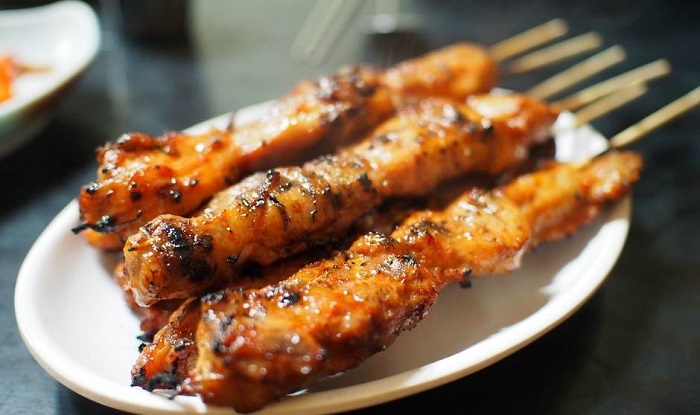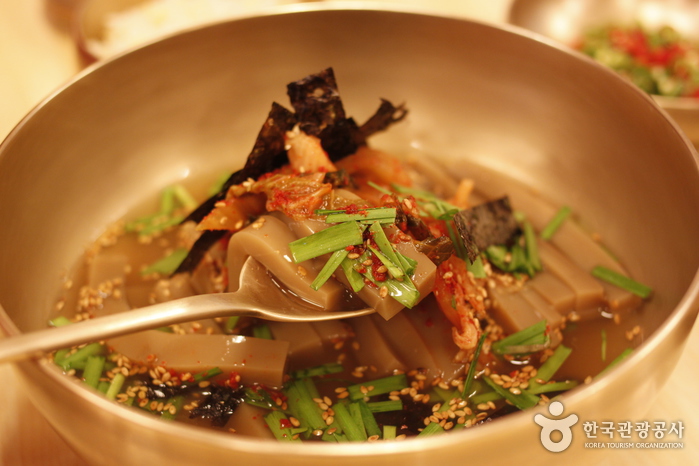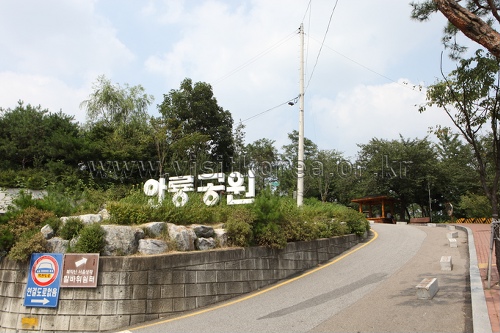Geumdwaeji Sikdang (금돼지식당)
2.3Km 2024-10-30
149, Dasan-ro, Jung-gu, Seoul
Geumdwaeji Sikdang est réputé comme l'un des meilleurs restaurants de plats de porc à Séoul et propose des plats typiques comme le Bonsamgyeop.
NUHADANG [Korea Quality] / 누하당 [한국관광 품질인증]
2.3Km 2020-09-10
49-7, Pirundae-ro, Jongno-gu, Seoul
010-9692-1330
Guesthouse Nuha is a ‘hanok’ or traditional Korean house consisting of four guestrooms located in Nuha-dong, Seochon (west of Gyeongbokgung Palace, Jongno, Seoul) where many Confucian scholars and artists lived during the Joseon Dynasty.
Exuding a refined atmosphere, Guesthouse Nuha is very popular among not only domestic visitors but also foreign tourists who want to experience the flavor of Korea in a cozy hanok. All four guestrooms (An-bang, Sarang-bang, Geul-bang, and Byeol-dang) are covered with eco-friendly hanji (traditional Korean paper handmade from mulberry tree) wallpaper, and are equipped with a thick cotton-wool comforter and pillows imbued with the scent of Hinoki cypress tree to help guests relieve their fatigue.
Breakfast is served free of charge. Guests can also experience traditional Korean culture here, such as playing a Korean musical instrument (janggu or double-headed drum), playing a game of yut in the yard, or wearing hanbok (traditional Korean clothes). Although a local bus service passes through the village, it is highly recommended to take a quiet leisurely around the area.
Hosujip (호수집)
2.3Km 2021-03-30
443, Cheongpa-ro, Jung-gu, Seoul
+82-2-392-0695
It is a restaurant where people wait in line as a hidden restaurant for locals in Chungjeong-ro. The best menu at this restaurant is spicy braised chicken. This Korean dishes restaurant is located in Jung-gu, Seoul.
Gungnara Naengmyeon Mukbap (궁나라냉면묵밥)
2.3Km 2017-04-12
6, Jibong-ro 12-gil, Jongno-gu, Seoul
+82-2-744-4701
Gungnara Naengmyeon Mukbap originally opened in Ansan, serving up delicious meals of naengmyeon and mukbap. The restaurant became popular, and eventually moved to its current location in Seoul. The jiggly acorn jelly goes well wit the sweet and sour broth in mukbap, a favorite summer-time dish. Visitors can also order the dish with a warm broth for a delicious and healthy dish year round.
Parc Waryong (와룡공원)
2.4Km 2020-07-15
192, Waryonggongwon-gil, Jongno-gu, Seoul
+82-2-2148-2845
Situé à Myeongryun-dong (Séoul), et établit en 1984, le Parc Waryong se trouve près de Malbawi, l’un des plus beaux endroits pour admirer Séoul. Le Parc est proche de destinations touristiques naturelles telles que les Parcs Samcheong et Changgyeong et le Mont Bukak.
Bien qu’il fut difficile d’y faire pousser des arbres (de même dans d’autres parties du pays) en raison de la platitude du sol, de nombreux citoyens participèrent à une campagne nationale pour en planter plus de dix millions à travers le pays. Cela a eu pour effet de transformer des endroits tels que Waryong en des zones luxuriantes remplies de plantes à fleurs.
Les fleurs du printemps font jaillir les assortiments de couleurs des cerisiers, des fleurs d’abricotiers, des azalées et des forsythias, faisant du parc une destination populaire pour les familles. Il y a aussi une variété d’excellentes installations : des terrains de badminton, des lieux pour l’aérobic, des équipements pour le fitness, et des pavillons, merveilleux pour les exercices, la marche ou pour simplement se reposer.
Un célèbre chemin de randonnée, entre la Muraille de Séoul et le Parc Samcheong, passe à travers le parc. Bordé de cerisiers, ce chemin attire une foule d’amoureux de la nature toute l’année mais particulièrement au printemps. Il passe aussi par la Muraille au Mont Bukak.
Bon PALETE (봉파레트)
2.4Km 2021-03-29
57-1, Seongbuk-ro, Seongbuk-gu, Seoul
+82-2-766-0827
You can enjoy delicious meals at a hanok restaurant. This Western dishes restaurant is located in Seongbuk-gu, Seoul. The representative menu is seafood pasta.
Gare de Séoul (서울역)
2.4Km 2018-07-04
405, Hangang-daero, Yongsan-gu, Seoul
+82-2-1544-7788, +82-2-1588-7788
La gare de Séoul (Seoul Station) est la porte d’entrée pour Séoul, la capitale de la Corée du Sud. C’est le terminus de toutes les lignes Gyeongbu (Séoul – Busan) pour les trains KTX (Korea Train Express), Saemaul, Mugunghwa et Nooriro (trains écologiques). Elle est également reliée à l’aéroport international d'Incheon grâce à la ligne AREX (Airport Express).
La gare de Séoul compte le plus grand nombre de passagers en Corée, avec une moyenne de 100 000 passagers franchissant quotidiennement les portes du complexe de la gare, qui inclut le nouveau bâtiment achevé en 2003. On y trouve également le grand magasin Galleria et un supermarché Lotte.
Magasin d’usine Lotte Outlet - branche de la gare de Séoul (labellisé Korea Quality) (롯데아울렛 서울역점[한국관광품질인증/Korea Quality])
2.4Km 2020-04-09
405, Hangangdaero, Yonsan-gu, Séoul
+82-2-6965-2500
Présent à Séoul depuis août 2010, cette célèbre enseigne de la mode décontractée a récemment été rénovée. Elle abrite à présent la Fashion Company Shop (magasin multimarques), le « Hobby Square » (jouets pour les enfants et les adolescents), ainsi qu’un magasin d’usine, une boutique d’articles de voyage, une boutique de mode unisexe et bien d’autres surprises que l’on ne peut trouver qu’ici.

![NUHADANG [Korea Quality] / 누하당 [한국관광 품질인증]](http://tong.visitkorea.or.kr/cms/resource/58/2532358_image2_1.jpg)



![Magasin d’usine Lotte Outlet - branche de la gare de Séoul (labellisé Korea Quality) (롯데아울렛 서울역점[한국관광품질인증/Korea Quality])](http://tong.visitkorea.or.kr/cms/resource/32/2652032_image2_1.jpg)
 Français
Français
 한국어
한국어 English
English 日本語
日本語 中文(简体)
中文(简体) Deutsch
Deutsch Español
Español Русский
Русский